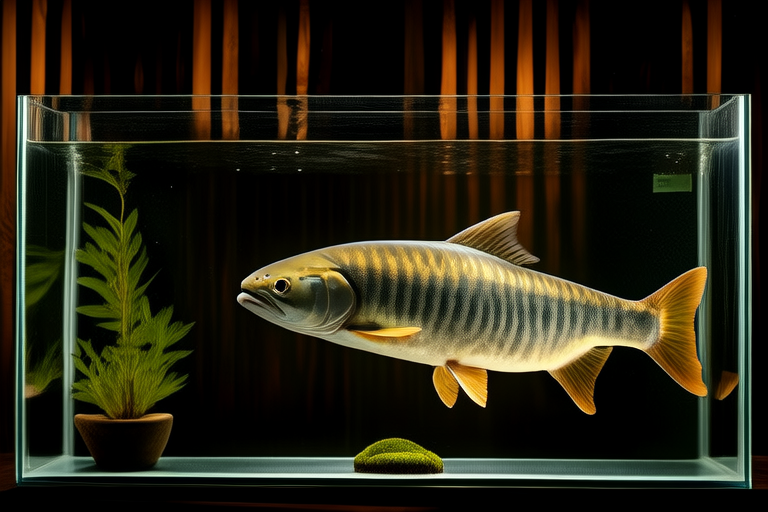From River to Tank: The Ultimate Guide to Arowana Care
Welcome to the world of arowanas, one of the most fascinating and majestic fish species that grace aquariums around the globe. Known for their striking appearance and impressive size, these freshwater giants require specific care and attention to thrive in captivity. This guide will walk you through the essentials of arowana care, from setting up the perfect tank environment to ensuring their dietary needs are met and maintaining optimal water conditions.
Setting Up the Optimal Tank Environment
Creating a suitable habitat for your arowana is paramount to their health and well-being. Start by selecting an appropriately sized tank; arowanas can grow up to three feet in length, so a minimum tank size of 180 gallons is recommended for a single adult. Larger tanks are ideal as they provide more swimming space and help maintain stable water conditions.
Water parameters play a crucial role in arowana care. These fish prefer slightly acidic to neutral water with a pH between 6.5 and 7.5. Temperature should be maintained between 75°F and 82°F (24°C to 28°C). To achieve this, invest in a reliable heater and thermometer. Regular monitoring of these parameters ensures a stable and comfortable environment for your arowana.
Filtration systems are essential for maintaining water quality. Arowanas produce a significant amount of waste, so a powerful filtration system that includes mechanical, biological, and chemical filtration is necessary. Consider a combination of external canister filters and internal power filters to handle the volume of water effectively. Additionally, perform weekly partial water changes, about 10-15% of the total volume, to keep the water fresh and clean.
Dietary Needs and Feeding Habits
Arowanas are carnivorous and have specific dietary requirements. In the wild, they feed on insects, small fish, and crustaceans. In captivity, it’s important to replicate their natural diet as closely as possible. Suitable food options include high-quality pellets designed for large predatory fish, live or frozen foods such as feeder fish, earthworms, and shrimp. Some aquarists also offer chopped meat or fish, but this should be done sparingly to avoid overfeeding.
Feeding habits vary among individuals, but generally, arowanas should be fed two to three times per week. Overfeeding can lead to health problems, so monitor their eating habits carefully. It’s advisable to feed them enough food that they can consume within a few minutes. Uneaten food should be removed promptly to prevent contamination of the water.
Common Health Issues and Preventive Care
Despite being robust fish, arowanas are susceptible to certain health issues. Common ailments include bacterial infections, fungal growth, and parasitic infestations. Signs of distress may include lethargy, loss of appetite, abnormal swimming patterns, or visible lesions on the body. If you notice any of these symptoms, it’s crucial to act promptly and consult a veterinarian specializing in exotic fish.
To prevent health issues, maintain pristine water quality and provide a stress-free environment. Regular water changes, proper filtration, and a balanced diet are key to keeping your arowana healthy. Quarantine new additions to the tank to prevent the introduction of diseases, and ensure all equipment and decorations are clean before introducing them to the aquarium.
Maintaining Water Quality and Tank Hygiene
Maintaining excellent water quality is vital for the longevity and health of your arowana. Besides regular water changes, consider using water conditioners to remove harmful chemicals like chlorine and chloramines. Test kits are indispensable tools for monitoring water parameters such as ammonia, nitrite, and nitrate levels. High levels of these substances can be toxic to your fish, so addressing them promptly is crucial.
Tank hygiene involves cleaning the substrate, decorations, and equipment regularly. Use appropriate tools to siphon out debris and uneaten food from the substrate. Avoid overcrowding the tank with decorations as this can hinder water flow and contribute to poor water quality. Regular maintenance ensures that your arowana’s environment remains pristine and inviting.
Compatible Tank Mates and Breeding Practices
Selecting compatible tank mates for your arowana requires careful consideration. Due to their aggressive nature and territorial behavior, it’s best to house them singly or with similarly-sized, non-aggressive species. Some suitable companions include larger catfish, pacu, and other large, peaceful fish. However, always research thoroughly to ensure compatibility before introducing new species to the tank.
Breeding arowanas in captivity is challenging but rewarding. They are known to build bubble nests for their eggs, and parental care is highly developed. To encourage breeding, maintain optimal water conditions and provide ample hiding spots for the fish to feel secure. Once breeding occurs, separate the parents from the fry to prevent cannibalism. Raising fry requires specialized care, including smaller tanks, high-quality food, and regular water changes.
Conclusion
Caring for arowanas is a rewarding endeavor that demands dedication and knowledge. By following the guidelines outlined in this guide, you can create a thriving environment for these magnificent creatures. Remember, the key to successful arowana care lies in understanding their unique needs and providing consistent, attentive care. With patience and commitment, you’ll enjoy the beauty and grace of these aquatic giants for years to come.
